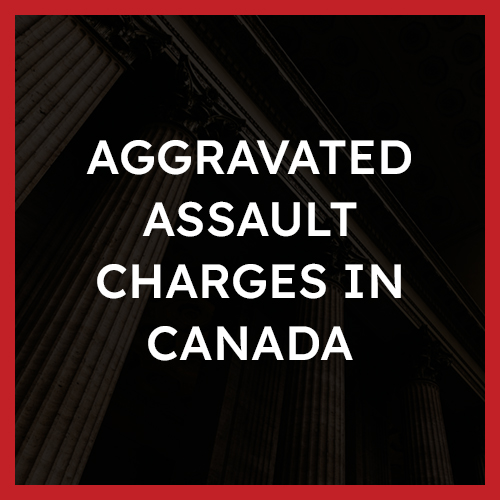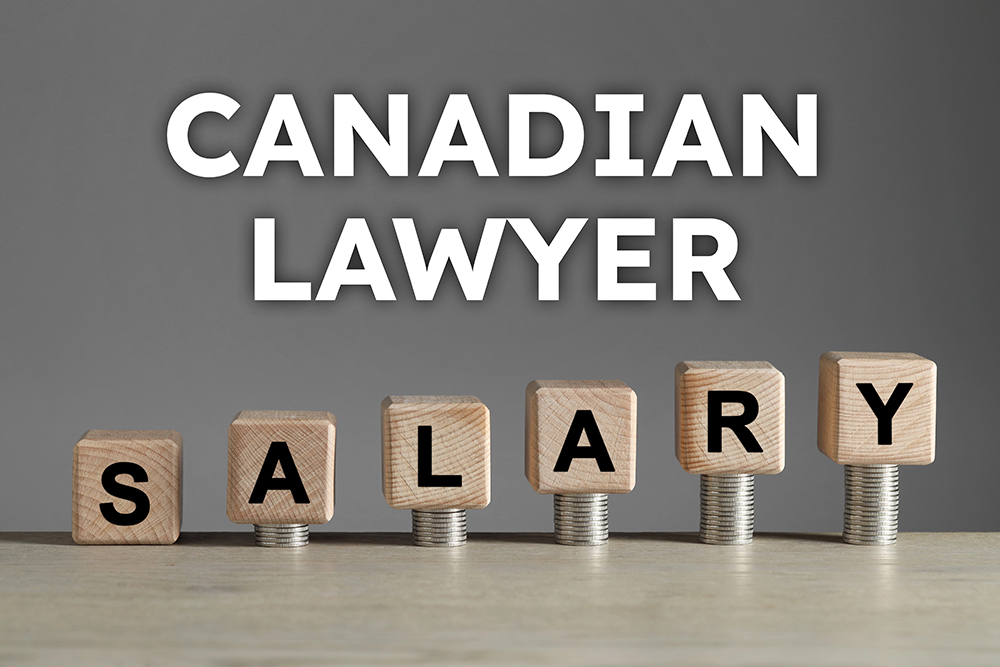Aggravated Assault (s. 268) Laws in Canada
 What is aggravated assault?
What is aggravated assault?
Aggravated assault is covered under s. 268 of the Criminal Code.
Aggravated assault is considered the most serious of all assault charges. Aggravated assault occurs when you wound, maim, disfigure or endanger the life of another. In other words, this would be an assault in which the injuries are more than just minor or serious bodily harm; rather, they are serious injuries whose effect lasts a long time on the victim.
Aggravated assault charges are straight indictable. This means that the Crown does not have the option to proceed summarily and must only choose to proceed by way of indictment.
Examples
Some common examples of aggravated assault may be the following:
- Breaking someone’s jaw;
- Breaking someone’s nose that doesn’t heal without medical intervention;
- Cutting someone’s skin; or
- Threatening to kill someone while pointing a gun at them;
Defences
A strong defence to an aggravated assault charge will depend on the specific circumstances of your case and any aggravating or mitigating factors present. However, some defences that may be raised against an aggravated assault charge may be the following:
- Identity;
- Self-defence;
- Defence of Another;
- Defence of Property;
- Reflex Action; or
- Any applicable Charter
Punishments
Aggravated assault is a straight indictable offence. Depending on the circumstances of your case and whether there are any aggravating or mitigating factors present you may receive a penalty of up to 14 years in jail.
Overview of the Offence
Under s. 268 of the Criminal Code:
(1) Every one commits an aggravated assault who wounds, maims, disfigures or endangers the life of the complainant.
For the purposes of aggravated assault, assault is defined in s. 265 of the Criminal Code which states that:
(1) A person commits an assault when
(a) without the consent of another person, he applies force intentionally to that other person, directly or indirectly;
The Crown must first satisfy that there was an assault that occurred by meeting the definition of assault provided in s.265(1)(a) of the Criminal Code to secure a conviction of aggravated assault.
Once it has been satisfied that an assault has taken place, the Crown must prove the essential elements of an aggravated assault. In order for the Crown to secure a conviction of aggravated assault, the actus reus and the mens rea needs to be proven beyond a reasonable doubt.
The Guilty Act (Actus reus)
The actus reus that the Crown must prove, beyond a reasonable doubt, is the following:
- That you wounded, maimed, disfigured or endangered a life
For the purposes of this section, the term “wound” means that there is a break in the continuity of both the epidermal and dermal layers of the skin that constitutes serious bodily harm. This means that there should be a breaking of the skin. Wound also refers to any cutting of the skin or tissue that causes bleeding. Generally, the term “wound” has been read to refer to permanent damage that the complainant may suffer.
The term “maiming”, for the purposes of an aggravated assault, requires that there be a hurt to the body that lessens the person’s function. For example, this would include the breaking of bones.
The term “disfigure” has been interpreted to refer to injuries that are more than a temporary marring of the figure of appearance.
In order for one to have “endangered a life” for the purposes of aggravated assault, this does not require proof of any bodily harm. Rather, what is required is that the conduct must endanger the complainant’s life and not merely have the potential to endanger life.
Guilty Mind (Mens rea)
The mens rea that the Crown must prove, beyond a reasonable doubt, to secure a conviction of aggravated assault is:
- That there was objective foresight of bodily harm
As seen in the case of R v Godin, [1994] 2 SCR 484 the mens rea for aggravated assault is objective foresight of bodily harm. This means that the court needs to determine whether any reasonable person would inevitably realize that their actions were subject to a risk of, at least, some harm. Additionally, the Crown does not need to prove that there was intent to maim, wound or disfigure. This is because the offence of aggravated assault criminalizes the actual assault rather than the desire to bring about the consequence.
Aggravated Assault Defences
How to Beat an Aggravated Assault Charge
A good defence will depend on the circumstances of your offence and the evidence against you.
However, the following defences may be raised when dealing with an aggravated assault charge:
- Identity;
- Self-defence;
- Defence of Another;
- Defence of Property;
- Reflex Action; or
- Any applicable Charter
Identity
Depending on the circumstances of your case, a possible defence to an aggravated assault charge may be to raise an identity defence. Sometimes, false accusations of aggravated assault can occur, and a wrong person is charged as a result. For example, in some cases, the complainant may not be able to clearly identify the perpetrator and end up accusing the wrong person or the authorities may have made a mistake in identifying you as the perpetrator. This would be a case of mistaken identity. In order for this defence to be raised successfully, you will have to prove that you were not present at the time of the offence. This can be done by corroborating evidence, such as an alibi, to remove you from the time of the offence
Self-Defence
In certain situations, it is acceptable to respond to force, or threats of force, with force. In these situations, you may be able to rely on self defence against your aggravated assault charge. To successfully argue self-defence it must be proven, on a balance of probabilities, that there is an “air of reality” to your claim, that you subjectively believed on reasonable grounds that force, or a force of threat, was being used against you, your conduct had a defensive purpose, and your conduct was objectively reasonable in the circumstances. If you successfully raise a defence of self-defence it will serve as a justification for your conduct, and you will be acquitted.
Defence of Another
Similarly, with the defence of self-defence, reasonable force or the threat of force can also be used to defend someone else against an unlawful attack, provided there was no intent to cause death or grievous bodily harm. If raised successfully, this defence acts as a full defence which means that it serves as a justification for your conduct, and you will be acquitted.
Defence of Property
You may also be able to raise the defence of property found under s.35 of the Criminal Code against an aggravated assault charge. This defence typically arises when an individual’s peaceful possession of property is threatened or someone is trying to take, damage, or trespass on your property. Given that the force that you used against the threat of force, or the force was reasonable you may be able to successfully raise this defence. However, in practice, this defence is seldomly raised.
Reflex Action
Reflex actions are involuntary physical actions which result because of some external source. In order to be convicted of aggravated assault, the Crown needs to prove both the actus reus and the mens rea of the offence. An involuntary act, such as a reflexive action, would negate the requisite intent that would be required for a Crown to secure an aggravated assault conviction. In order to raise this defence successfully, it must be showcased that the accused’s act was an involuntary response over which the accused has no control and would be considered akin to an automatic response to nerve stimulation.
Applicable Charter Defences
The Charter sets out your rights and freedoms before and after your arrest. If the police fail to abide by these rights, either deliberately or inadvertently, it could aid in your defence. If any of your Charter rights have been violated before or after your arrest, you may be able to have some or all of the evidence that the Crown is relying on to secure a conviction excluded under s.24(2) of the Charter.
Aggravated Assault Punishment
The sentence that you receive for a conviction of an aggravated assault offence will take into account the individual circumstances of your matter. Aggravated assault charges are serious convictions in which you may receive jail time, even for a first offence. An aggravated assault charge is an indictable offence, and you can receive a maximum of 14 years in jail if convicted.
You will also have available to you a suspended sentence, fine alone, fine and probation, prison and probation, intermittent sentence, prison and fine, and affine, probation and intermittent sentence. Note you will not have available to you a discharge or a conditional sentence.
Additionally, it is important to note that a person convicted of aggravated assault cannot be convicted of a lesser form of assault for the same conduct. Lesser included offences include common assault and assault causing bodily harm.
Frequently Asked Questions
Is aggravated assault a criminal offence?
Yes, aggravated assault is a serious criminal offence in Canada found under s.268 of the Criminal Code. This is a straight indictable offence, and you can receive up to 14 years in jail.
What is the minimum sentence for assault in Canada?
There are three levels of assault in Canada:
- Common assault;
- Assault with a weapon/ causing bodily harm; and
- Aggravated Assault.
Each level of assault in Canada does have associated with it maximum penalties that you may receive if you are convicted of the offence. However, there are no minimum penalties associated with assault charges.
What is the difference between assault causing bodily harm and aggravated assault?
The main difference between assault causing bodily harm and aggravated assault relates to the severity of the injuries sustained by the victim.
For assault causing bodily harm, the injuries need to have interfered with the victim’s health or comfort in a way that is more than merely transient or trifling in nature. Bodily harm can also include psychological injury.
On the other hand, aggravated assault has a high threshold to meet in regard to the severity of the injuries. For aggravated assault, the injuries have to be serious in that the complainant is wounded, maimed, disfigured or suffered life-threatening injuries whose effects last a lifetime.
Another difference between aggravated assault and assault causing bodily harm is that aggravated assault is a straight indictable offence, while assault causing bodily harm is a hybrid and depending on the circumstances of your case the Crown can choose to proceed either by indictment or summarily.
Published Decisions
R v Bear, 2013 MBCA 96 (CanLII)
In this case, the accused was convicted of common assault after he spat in the face a police officer. However, on appeal this charge was upgraded to attempted aggravated assault the accused spit on the police officer in an attempt to transmit his HIV infection. Given the fact that the officer did not contract HIV, the accused was not convicted of aggravated assault.
You can read the full decision here.
R v Carriere, 1987 ABCA 39 (CanLII)
In this case, the accused was charged with aggravated assault after she stabbed another woman in the abdomen. The accused argued that since the victim agreed to a knife fight she should not be charged with aggravated assault. The court found that one cannot consent to being stabbed and the accused was found guilty of aggravated assault.
You can read the full decision here.
R v Godin, 1993 CanLII 5289 (NB CA)
In this case, the accused was charged with aggravated assault after bringing a baby to the hospital who was later found to have a traumatic head injury. The accused indicated that he panicked when the baby started to choke on medication that he had given and sometime during this chaos he accidentally banged the baby’s head. The court found that the accused was guilty of aggravated assault regardless of the fact that the accused had no intention to maim the child. The mere fact that the maiming occurred was enough to find the accused guilty of aggravated assault.
You can read the full decision here.
About The Author





 What is aggravated assault?
What is aggravated assault?

